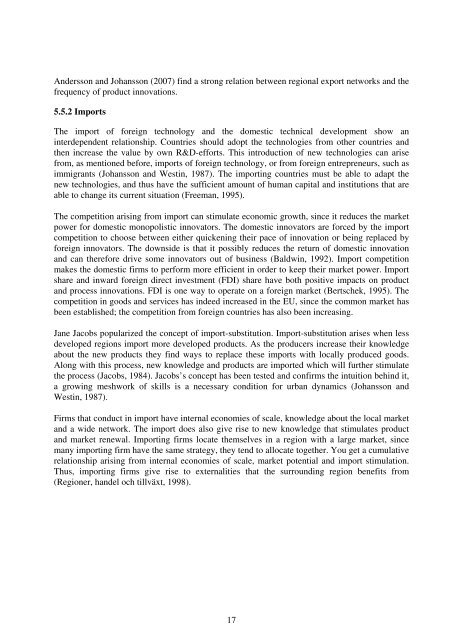INNOVATION POLICY INSTRUMENTS
INNOVATION POLICY INSTRUMENTS
INNOVATION POLICY INSTRUMENTS
Create successful ePaper yourself
Turn your PDF publications into a flip-book with our unique Google optimized e-Paper software.
Andersson and Johansson (2007) find a strong relation between regional export networks and the<br />
frequency of product innovations.<br />
5.5.2 Imports<br />
The import of foreign technology and the domestic technical development show an<br />
interdependent relationship. Countries should adopt the technologies from other countries and<br />
then increase the value by own R&D-efforts. This introduction of new technologies can arise<br />
from, as mentioned before, imports of foreign technology, or from foreign entrepreneurs, such as<br />
immigrants (Johansson and Westin, 1987). The importing countries must be able to adapt the<br />
new technologies, and thus have the sufficient amount of human capital and institutions that are<br />
able to change its current situation (Freeman, 1995).<br />
The competition arising from import can stimulate economic growth, since it reduces the market<br />
power for domestic monopolistic innovators. The domestic innovators are forced by the import<br />
competition to choose between either quickening their pace of innovation or being replaced by<br />
foreign innovators. The downside is that it possibly reduces the return of domestic innovation<br />
and can therefore drive some innovators out of business (Baldwin, 1992). Import competition<br />
makes the domestic firms to perform more efficient in order to keep their market power. Import<br />
share and inward foreign direct investment (FDI) share have both positive impacts on product<br />
and process innovations. FDI is one way to operate on a foreign market (Bertschek, 1995). The<br />
competition in goods and services has indeed increased in the EU, since the common market has<br />
been established; the competition from foreign countries has also been increasing.<br />
Jane Jacobs popularized the concept of import-substitution. Import-substitution arises when less<br />
developed regions import more developed products. As the producers increase their knowledge<br />
about the new products they find ways to replace these imports with locally produced goods.<br />
Along with this process, new knowledge and products are imported which will further stimulate<br />
the process (Jacobs, 1984). Jacobs’s concept has been tested and confirms the intuition behind it,<br />
a growing meshwork of skills is a necessary condition for urban dynamics (Johansson and<br />
Westin, 1987).<br />
Firms that conduct in import have internal economies of scale, knowledge about the local market<br />
and a wide network. The import does also give rise to new knowledge that stimulates product<br />
and market renewal. Importing firms locate themselves in a region with a large market, since<br />
many importing firm have the same strategy, they tend to allocate together. You get a cumulative<br />
relationship arising from internal economies of scale, market potential and import stimulation.<br />
Thus, importing firms give rise to externalities that the surrounding region benefits from<br />
(Regioner, handel och tillväxt, 1998).<br />
17
















